
Best Indoor Vines & Climbers: Easy Growing Tips for Home
Do you like to grow plants indoors? Indoor creepers and vines in hanging baskets, shelves and tables can turn any room into an inviting and beautiful indoor garden-like space!
Transform your room with the eye-catching beauty of these best indoor vines and climbers! Whether you grow them in pots or hang them from the ceiling, they effortlessly liven up and beautify the environment!
1. Heartleaf Philodendron

Botanical Name: Philodendron hederaceum
Heartleaf Philodendron is a popular trailing houseplant with heart-shaped, glossy leaves, valued for its ease of care and adaptability to various indoor environments.
Air Purifying: Excellent air-purifier, filters toxins for healthier indoor spaces.
Sun exposure: Thrives in bright indirect light, versatile for various indoor spots.
Temperature: 65°F to 85°F (18°C to 29°C).
Care: Well-draining soil, moderate water, bright indirect light, occasional pruning.
Watering: Allow top inch soil to dry, keep evenly moist to avoid overwatering and root rot.
Propagation: Propagate with stem cuttings, two nodes, water or well-draining soil for roots.
Fertilization: Half-strength balanced fertilizer every 4-6 weeks in spring and summer for healthy growth.
Height: Grows 6 to 10 feet tall (1.8 to 3 meters).
Hardiness Zone: 10 to 12, above 30°F (-1°C) minimum temperature.
2. String Of Pearls

Botanical Name: Senecio rowleyanus
Commonly known as String of Pearls, a unique and popular succulent with trailing stems adorned with small, bead-like leaves.
Air Purifying: Enhances indoor air quality with unique trailing succulent growth.
Sun exposure: Thrives in bright, indirect sunlight, tolerates some shade.
Temperature: Prefers 65°F to 80°F (18°C to 27°C), avoid extreme cold or hot conditions.
Care: Bright, indirect light, 65°F to 80°F (18°C to 27°C), water when soil is dry, partial drying between waterings.
Watering: Water when soil is dry, allow partial drying to avoid overwatering.
Propagation: Propagate stem cuttings, callus before placing in well-draining soil to root.
Fertilization: Fertilize sparingly, every 2-4 months in spring and summer with diluted balanced liquid fertilizer.
Height: Grows 6-12 inches (15 to 30 cm) in height, trailing stems can reach several feet.
Hardiness Zone: 9 to 11, best grown as a houseplant or protected in colder climates.
3. Grape Ivy
Botanical Name: Cissus rhombifolia
Grape Ivy or Oak Leaf Ivy is a beautiful and versatile houseplant belonging to the Vitaceae family. It is native to tropical regions of Central and South America.
Air Purifying: Air-purifying qualities, improves indoor air quality by removing toxins.
Sun exposure: Low-maintenance, thrives in various indoor conditions, prefers bright indirect light for optimal growth.
Temperature: 65°F to 75°F (18°C to 24°C), avoid extreme cold or drafts.
Care: Hassle-free, no frequent repotting, low pest and disease susceptibility.
Watering: Keep evenly moist, allow top inch soil to dry before watering, avoid overwatering to prevent root rot.
Propagation: Propagate stem cuttings, root in water or well-draining potting mix.
Fertilization: Liquid fertilizer every 2-4 weeks in spring and summer.
Height: Climbing height up to 6 to 10 feet (1.8 to 3 meters).
Hardiness Zone:10 to 12, minimum temperature 30°F (-1°C).
4. Swiss-cheese Plant
Botanical Name: Monstera Deliciosa
Monstera deliciosa, commonly known as split-leaf philodendron, is a popular tropical houseplant and ornamental vine. Native to the rainforests of Central America, particularly in southern Mexico and Panama, this plant is well-loved for its striking appearance and relatively easy care requirements.
Air Purifying: Natural air purifier, toxin-absorbing leaves, humidity-enhancing.
Sun exposure: Bright indirect light preferred, avoid extended direct sunlight, tolerate some shade for balanced growth.
Temperature:Keep warm, 65°F to 85°F (18°C to 29°C), avoid drafts, temperatures below 50°F (10°C).
Care:Low-maintenance, popular for indoor gardening.
Watering: Water when top inch soil is dry, avoid overwatering, ensure good drainage to prevent root rot.
Propagation: Propagate with a node cutting, root in water or moist soil, plant in new pot.
Fertilization: Balanced liquid fertilizer every 2-4 weeks in spring and summer, reduce/stop in winter.
Height: Indoors, grows 3 to 8 feet (1 to 2.4 meters) or more, depending on conditions and space.
Hardiness Zone: Native to tropical Central America, USDA Hardiness Zones 10 to 12.
5: String Of Nickels

Botanical Name: Dischidia nummularia
Dischidia nummularia, commonly known as String of Nickels or Button Orchid, is a trailing epiphytic plant with small, round, succulent-like leaves, popular for its ornamental value in hanging baskets and terrariums.
Air Purifying: Limited air purifying, aids air circulation and humidity indoors.
Sun exposure: Prefers bright, indirect light, can handle some filtered sun.
Temperature: Thrives in 65°F to 85°F (18°C to 29°C), great for indoor and tropical climates.
Care: Needs well-draining soil, regular watering, high humidity, occasional pruning.
Watering: Keep soil consistently moist, avoid waterlogging, allow top inch to dry between waterings to prevent root rot.
Propagation: Propagate via stem cuttings or layering, maintain proper humidity and moisture for successful root development.
Fertilization: Half-strength balanced liquid fertilizer in spring and summer for lush growth.
Height: Stems grow 1 to 3 feet long.
Hardiness Zone: 10 to 12, where temperatures do not drop below 30°F (-1°C)
6: Arrowhead Plant
Botanical Name: Syngonium podophyllum
Arrowhead Plant is a popular and easy-to-care-for houseplant with arrowhead-shaped leaves.
Air Purifying: Filters indoor air, improves its quality.
Sun exposure: Thrives in bright, indirect light, tolerates some shade.
Temperature: Prefers 60°F to 75°F (15°C to 24°C), avoid extreme cold or hot conditions.
Care: Bright, indirect light, 60°F to 75°F (15°C to 24°C), water when top inch soil is dry.
Watering: Water when top inch soil is dry, allow partial drying between waterings.
Propagation: Propagate stem cuttings in water or moist soil until roots develop.
Fertilization: Fertilize every 4-6 weeks in spring and summer with balanced liquid fertilizer.
Height: Grows 1-3 feet (30 to 90 cm) in height, trails longer with vining growth.
Hardiness Zone: 9 to 11, best indoors or protected in colder climates.
7: Adanson’s monstera
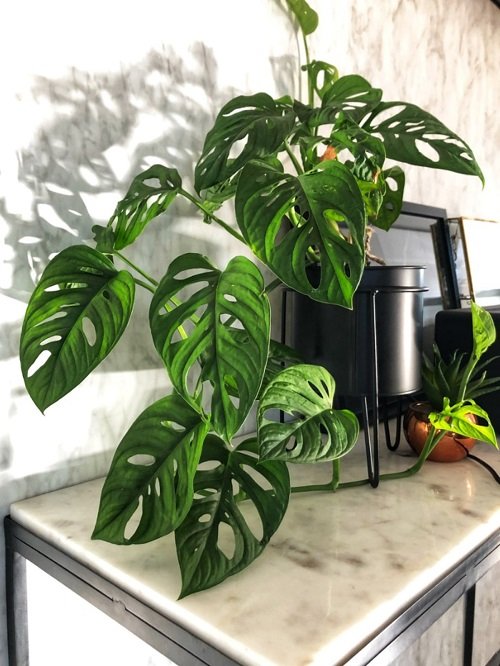
Botanical Name: Monstera adansonii
Monstera adansonii plant known as Swiss cheese vine or monkey mask plant, is a captivating and popular houseplant with unique foliage and a trailing growth habit.
Air Purifying: Air-purifying, toxin-absorbing foliage improves indoor air quality.
Sun exposure: Bright indirect light preferred, avoid direct sun to prevent leaf scorching.
Temperature: Thrives in temperatures between 65°F to 85°F (18°C to 29°C).
Care: Indirect light, 65°F to 85°F temperatures, moderate watering when top inch soil is dry.
Watering: Water when top inch soil is dry, allowing partial drying between waterings.
Propagation: Propagate through stem cuttings in water or moist soil until roots develop..
Fertilization: Fertilize balanced liquid every 2-4 weeks in spring and summer, reduce or stop in winter..
Height: Grows 1-3 feet indoors, trails longer with vining habit..
Hardiness Zone: 10 to 12, best grown indoors in colder climates.
8: Betel Leaf Plant

Botanical Name: Piper betle
Piper betle – Also known as Betel Leaf, a tropical plant with aromatic leaves used in traditional medicine and cultural practices.
Air Purifying: Some air filtering properties, less effective than specialized purifiers.
Sun exposure: Thrives in partial to full sun, needs well-lit location for optimal growth.
Temperature: Prefers 65°F to 85°F (18°C to 29°C), protect from cold drafts or temperatures below 50°F (10°C).
Care: Partial to full sun, maintain 65°F to 85°F (18°C to 29°C).
Watering: Water regularly, keep soil consistently moist, avoid waterlogging.
Propagation: Propagate stem cuttings, root in water or moist soil until roots develop.
Fertilization: Fertilize every 4-6 weeks in spring and summer with balanced liquid fertilizer.
Height: Grows 1-3 feet (30 to 90 cm) in height, depending on conditions and care.
Hardiness Zone: 10 to 12, best in tropical and subtropical regions.
9: Hoya Hearts

Botanical Name: Hoya kerrii
Hoya kerrii commonly known as the Sweetheart Plant, a popular succulent with heart-shaped leaves, often gifted as a symbol of love and affection.
Air Purifying: Enhances indoor air quality with lush green foliage.
Sun exposure: Bright, indirect sunlight, tolerates shade, avoid prolonged direct sun to prevent leaf damage.
Temperature: 65°F to 80°F (18°C to 27°C), protect from cold drafts and extreme temperature fluctuations.
Care: Bright, indirect light, 65°F to 80°F (18°C to 27°C), water when top inch soil is dry, avoid overwatering.
Watering: Water when top inch soil is dry, allow partial drying to avoid overwatering.
Propagation: Propagate stem cuttings in water or moist soil until roots develop.
Fertilization: Fertilize sparingly, every 2-4 months in spring and summer, with diluted balanced liquid fertilizer.
Height: Grows 8-12 inches (20 to 30 cm) in height, varies with conditions and care.
Hardiness Zone: 10 to 12, best in tropical and subtropical regions or as a houseplant in colder climates.
10: Wandering Jew

Botanical Name: Tradescantia zebrina
Tradescantia zebrina is Commonly known as Wandering Jew or Zebrina plant, a popular trailing houseplant with striking purple and silver-striped leaves.
Air Purifying: Improves indoor air quality with lush foliage.
Sun exposure: Thrives in bright, indirect sunlight, tolerates some shade.
Temperature: Prefers 60°F to 75°F (15°C to 24°C), protect from extreme cold or hot conditions.
Care: Bright, indirect light, 60°F to 75°F (15°C to 24°C), water when top inch soil is dry, avoid overwatering.
Watering: Water when top inch soil is dry, allow partial drying to prevent overwatering.
Propagation: Propagate stem cuttings in water or moist soil until roots develop.
Fertilization: Fertilize every 2-4 weeks in spring and summer with balanced liquid fertilizer for healthy growth.
Height: Grows 6-12 inches (15 to 30 cm) in height, trailing stems can extend several feet.
Hardiness Zone: 9 to 11, best in mild climates or as a houseplant in colder regions.
11: English Ivy
12: Philodendron Nanegalense

Botanical Name: Philodendron nanegalense
A rare and tropical plant species, part of the Philodendron genus, is known for its attractive foliage and unique characteristics.
Air Purifying: Excellent air purifiers, removing formaldehyde gases, with quick-growing vines, and charming heart-shaped leaves.
Sun exposure: Thrives in bright, indirect sunlight, tolerates some shade.
Temperature: 65°F to 85°F (15°C to 30°C), protect from extreme temperatures.
Care: Bright, indirect light, 65°F to 85°F (18°C to 29°C), water when top inch is dry, avoid overwatering.
Watering: Water when top inch is dry, allow partial drying to avoid overwatering.
Propagation: Propagate with stem cuttings in water or moist soil till roots develop.
Fertilization: Fertilize every 2 months in winter and fall with balanced liquid fertilizer for healthy growth.
Height: Grows up to 6 feet long (1.8 meters) with trailing vines extending further.
Hardiness Zone: 9 through 11.
13: Forest Cactus

Botanical Name: Lepismium Bolivianum
Forest Cactus is a hanging epiphytic cactus with long, trailing stems and a unique appearance, native to Bolivia and other South American countries.
Air Purifying: Unique, indoor-friendly, potential air-purifier with distinct appearance.
Sun exposure: Flourishes indoors or in shaded outdoor spots, loves bright, indirect sunlight.
Temperature: Optimal temp 60°F to 80°F (15°C to 27°C), avoid extreme cold/heat.
Care: Indirect light, 60°F to 80°F (15°C to 27°C), water when dry, avoid overwatering.
Watering: Water when soil is dry, avoid overwatering, allow partial drying.
Propagation: Propagate via stem cuttings in well-draining soil.
Fertilization: Sparse fertilizing every 4-6 weeks in spring and summer.
Height: Grows 1 to 3 feet tall, trailing stems extend further.
Hardiness Zone: Best for mild climates or as a houseplant in colder regions (zones 9-11).
14: String Of Hearts

Botanical Name: Ceropegia woodii
Ceropegia woodii, commonly known as the String of Hearts or Rosary Vine, is a delicate and charming trailing plant with heart-shaped leaves.
Air Purifying: Limited air purifying, improves indoor air quality to some extent.
Sun exposure: Thrives in bright, indirect light, ideal for indoor spaces with filtered sunlight.
Temperature: Ideal for indoors (60°F to 80°F / 15°C to 27°C) and mild outdoors.
Care: Needs well-draining soil, moderate water, indirect sunlight, occasional pruning for health and beauty.
Watering: Allow partial soil drying to prevent overwatering and root rot.
Propagation: Propagate with stem cuttings, callus, plant in well-draining soil for roots.
Fertilization: Apply diluted balanced liquid fertilizer in spring and summer.
Height: Stems reach 4 to 6 inches in height.
Hardiness Zone: Suited for hardiness zone 11.
15: Creeping Fig
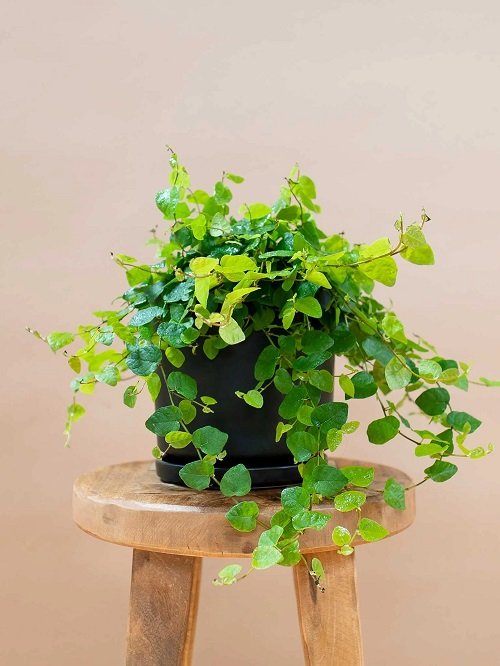
Botanical Name: Ficus pumila
Commonly known as Creeping Fig, a versatile vining plant with small, heart-shaped leaves often used for indoor and outdoor greenery.
Air Purifying: Air-purifying, improves indoor air quality.
Sun exposure: Thrives in bright, indirect sunlight, tolerates some shade.
Temperature: Prefers 60°F to 85°F (15°C to 29°C), avoid extreme cold.
Care: Bright, indirect light, 60°F to 85°F (15°C to 29°C), water when top inch soil is dry.
Watering: Water when top inch soil is dry, allow partial drying between waterings.
Propagation: Propagate stem cuttings in water or moist soil until roots develop.
Fertilization: Fertilize every 4-6 weeks in spring and summer with balanced liquid fertilizer.
Height: Grows 1-3 feet (30 to 90 cm) in height, spreads farther with trailing and vining habit.
Hardiness Zone: 9 to 11, best indoors or protected in colder climates.
16: Kangaroo Vine
Botanical Name: Cissus antarctica
Kangaroo Vine or Kangaroo Paw Fern, is a climbing plant with attractive, glossy, and serrated leaves, often used as a decorative houseplant or for green walls.
Air Purifying: Enhances indoor air quality, filters and refreshes air.
Sun exposure: Thrives in bright indirect light or partial shade, perfect for indoor or outdoor with filtered or dappled sunlight.
Temperature: Prefers 65°F to 80°F (18°C to 27°C), ideal for indoor and mild outdoor climates.
Care: Needs well-draining soil, moderate water, bright indirect light, occasional pruning.
Watering: Let top inch soil dry between waterings to avoid overwatering, prevent root rot.
Propagation: Propagate with stem cuttings, two nodes, water or well-draining soil for new roots.
Fertilization: Fertilize every 2-4 weeks in spring and summer for healthy growth.
Height: Grows 3 to 6 feet tall (0.9 to 1.8 meters).
Hardiness Zone: 10 to 12, minimum temp. above 30°F (-1°C).
17: Black-Eyed Susan Vine
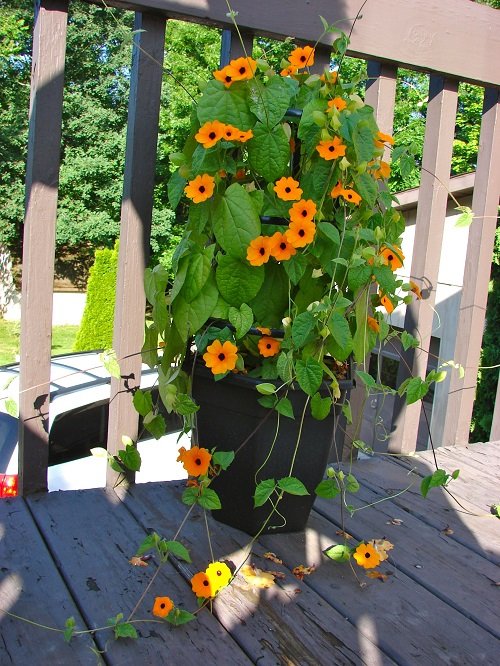
Botanical Name: Thunbergia alata
Thunbergia alata, also known as Black-eyed Susan vine, is a beautiful and fast-growing flowering plant with vibrant orange or yellow flowers, often used to add color and charm to gardens and trellises.
Air Purifying: Lush foliage and blooms create pleasing outdoor atmosphere.
Sun exposure: Thrives in full sun to partial shade, needs 6 hours of sunlight daily.
Temperature: 65°F to 85°F (18°C से 29°C).
Care: Well-drained soil, regular water, ample sunlight, periodic pruning.
Watering: Keep soil consistently moist, allow top inch to dry to avoid overwatering.
Propagation: Propagate with 4- to 6-inch stem cuttings, two nodes, root in soil or water for new roots.
Fertilization: Fertilize with balanced liquid fertilizer in spring and summer as directed by the manufacturer.
Height: Grows 6 to 8 feet tall (1.8 to 2.4 m).
Hardiness Zone: 9 to 11, above 25°F (-4°C) minimum temperature.
18. Pothos

Botanical Name: Epipremnum aureum
Pothos is a popular and beloved indoor plant that belongs to the Araceae family. It is native to Southeast Asia and is well-known for its attractive, heart-shaped leaves and easy care requirements. Pothos is often referred to as Devil’s Ivy due to its ability to grow vigorously and adapt to various conditions.
Air-Purifying Properties: Pothos is an excellent air-purifying plant, removing toxins like formaldehyde, benzene, and xylene, making it beneficial for indoor spaces.
Sun exposure: Pothos prefers bright, indirect light near windows, avoids direct sunlight for healthy growth.
Temperature: Pothos thrives in temperatures ranging from 65°F to 85°F (18°C to 29°C).
Care: Low-maintenance, ideal for all, tolerates neglect, quick recovery with adjusted care.
Watering: Water Pothos every 1-2 weeks when soil feels dry; check moisture by inserting finger 1 inch deep.
Propagation: Pothos propagation: Stem cuttings root in water or soil, developing into new plants..
Fertilization: Fertilize with balanced liquid fertilizer every 2-4 weeks around plant base.
Height: 6 to 10 feet (approximately 1.8 to 3 meters) in height.
Hardiness Zone: 10 to 12, where temperatures do not drop below 30°F (-1°C).
19. Jasmine

Botanical Name: Jasminum
Heartleaf Philodendron is a popular trailing houseplant with heart-shaped, glossy leaves, valued for its ease of care and adaptability to various indoor environments.
Air Purifying: Filters air, removes toxins and pollutants.
Sun exposure: Thrives in full sun to partial shade, needs 4-6 hours of sunlight daily.
Temperature: 60°F to 75°F (15°C to 24°C).
Care: Needs well-draining soil, regular water, ample sunlight, occasional pruning for healthy growth and abundant flowers.
Watering: Keep soil consistently moist, not waterlogged. Allow top inch to dry, adjust watering as needed.
Propagation: Propagate through softwood or semi-hardwood cuttings in well-draining soil or water. Layering stems in soil for new roots.
Fertilization: Fertilize with balanced fertilizer in spring and summer per manufacturer’s instructions for healthy growth and flowering.
Height: Height varies by species and variety, from a few feet to over 10 feet.
Hardiness Zone: 7 to 11, while others are best suited for zones 8 to 11.
20. Hindu Rope Plant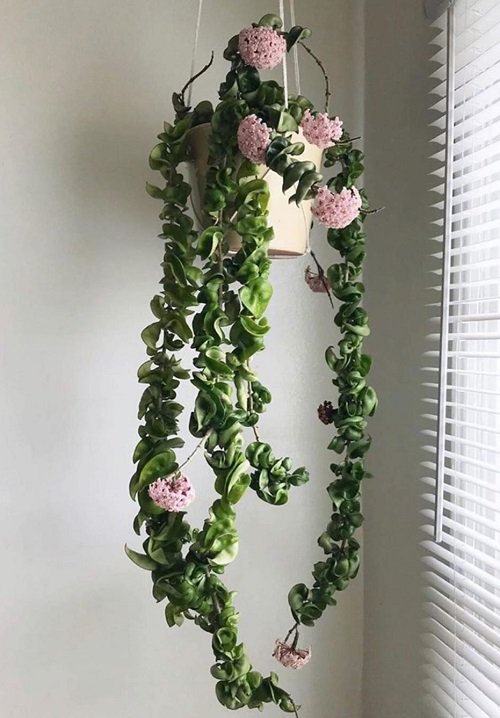
Botanical Name: Hoya carnosa ‘Compacta’
The Hindu Rope Plant (Hoya carnosa compacta) is a unique and fascinating succulent vine with thick, twisted, and waxy leaves, known for its captivating appearance and low-maintenance care requirements.
Air Purifying: Hoya carnosa compacta, air-purifier, filters and removes toxins indoors.
Sun exposure: Thrives in bright indirect light, perfect for indoor with filtered sunlight or near a window with a sheer curtain.
Temperature: 60°F to 75°F (15°C to 24°C).
Care: Well-draining soil, allow soil to dry between waterings, bright indirect light, warm temperatures for healthy growth and flowering.
Watering: Allow top inch soil to dry, water sparingly due to low water needs.
Propagation: Propagate with stem cuttings, callus, plant in well-draining soil for new roots.
Fertilization: Fertilize half-strength balanced liquid fertilizer in spring and summer for growth and occasional flowering.
Height: Grows 12 to 24 inches (30 to 60 centimeters).
Hardiness Zone: 10 to 12, above 30°F (-1°C) minimum temperature.
21. Rex Begonia Vine
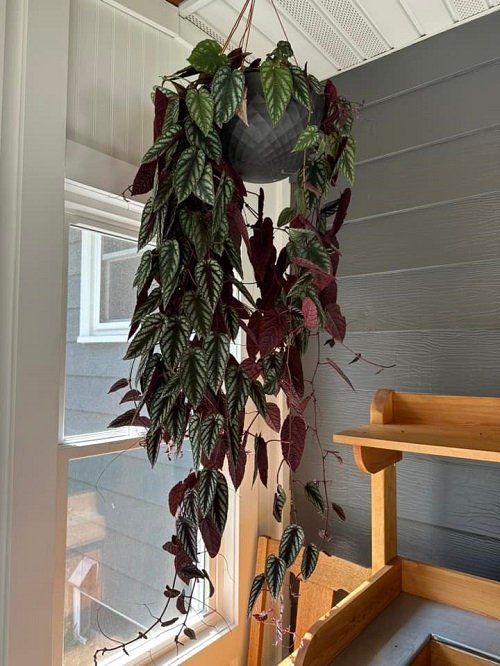
Botanical Name: Cissus discolor Blume
Rex Begonia Vine or Painted Wax Vine, is a stunning climbing plant with uniquely patterned, heart-shaped leaves, valued for its ornamental appeal in indoor spaces.
Air Purifying: Limited air purifying, enhances indoor oxygen and aesthetics.
Sun exposure: Thrives in bright, indirect light, perfect for indoor with filtered sunlight or outdoor partial shade.
Temperature: Prefers warm, temperate climate (65°F to 80°F / 18°C to 27°C).
Care: Needs well-draining soil, moderate water, bright indirect light, occasional pruning.
Watering: Water when top inch soil is dry, avoid waterlogging to prevent root rot.
Propagation: Propagate with 4-6 inch stem cuttings, two nodes, root in soil or water for new roots.
Fertilization: Half-strength balanced liquid fertilizer every 2-4 weeks in spring and summer.
Height: Grows 6 to 12 feet tall (1.8 to 3.6 meters).
Hardiness Zone: 10 to 12, above 30°F (-1°C) minimum temperature.
22. Wax Ivy

Botanical Name: Senecio macroglossus
Is a fast-growing, succulent vine with fleshy, heart-shaped leaves, often used as an attractive ground cover or hanging plant for indoor and outdoor locations.
Air Purifying: Limited air-purifying properties.
Sun exposure: Prefers indirect light or partial shade.
Temperature: 65°F to 75°F (18°C to 24°C)
Care: Well-draining soil, moderate water, bright indirect light, periodic pruning.
Watering: Let top inch soil dry between waterings, water sparingly to avoid overwatering.
Propagation: Propagated through stem cuttings.
Fertilization: Half-strength balanced liquid fertilizer in spring and summer.
Height: Grows 6 to 12 inches tall (15 to 30 centimeters).
Hardiness Zone: 9 to 11, minimum temp. above 25°F (-4°C).
23. Green Coins

Botanical Name: Peperomia ‘Pepperspot’
Peperomia ‘Pepperspot’ is a charming and compact houseplant with small, round leaves adorned with unique silver and green patterns, adding a delightful touch to indoor spaces.
Air Purifying: Low air purifier.
Sun exposure: Enjoys bright indirect light.
Temperature: 65°F to 80°F (18°C to 27°C).
Care: Needs well-draining soil, moderate watering.
Watering: Let top inch soil dry, ensure proper drainage to prevent overwatering.
Propagation: Propagated through stem cuttings.
Fertilization: Benefits from balanced liquid fertilizer in the growing season.
Height: Grows 6 to 8 inches tall (15 to 20 centimeters).
Hardiness Zone: 10 to 11, minimum temp 30°F to 40°F (-1°C to 4°C).
24. Passion Flower

Botanical Name: Passiflora
Passion Flower Exotic, vibrant flowers, edible fruits. Ornamental, medicinal, and culinary uses. Needs sun, well-draining soil, and support for climbing vines.
Air Purifying: Not air-purifying.
Sun exposure: prefers full sun to partial shade.
Temperature: Moderate temperatures, typically between 65°F to 85°F (18°C to 29°C).
Care: Sun to shade, moderate temps, well-draining soil, regular watering, trellis support, occasional pruning.
Watering: Regular watering, keep soil evenly moist.
Propagation: From seeds or stem cuttings.
Fertilization: Feed with balanced fertilizer during the growing season.
Height: Varies, 10-20 feet+ for some varieties, compact for others.
Hardiness Zone: 6 to zone 11.
25. Maidenhair Vine

Botanical Name: Muehlenbeckia complexa
Maidenhair Vine (Muehlenbeckia complexa) – charming, delicate, fern-like leaves, cascades gracefully indoors/outdoors. Easy care, bright light, well-draining soil. Popular for elegance and ornamental use.
Air Purifying: Maidenhair Vine is an air-purifying plant.
Sun exposure: Bright, indirect light. Avoid direct sun for leaf health.
Temperature: 65°F to 75°F (18°C to 24°C). Avoid extremes.
Care: Indirect light, moderate temp, even watering, higher humidity, well-draining soil, occasional pruning, watch for pests, report as needed.
Watering: Evenly moist, avoid waterlogging.
Propagation: Through stem cuttings in water or soil.
Fertilization: Balanced liquid fertilizer, 4-6 weeks, diluted.
Height: 6-12 inches (indoor) to 6 feet+ (outdoor).
Hardiness Zone: 9-11 (can adapt to cooler zones).
26. Teddy Bear Vine
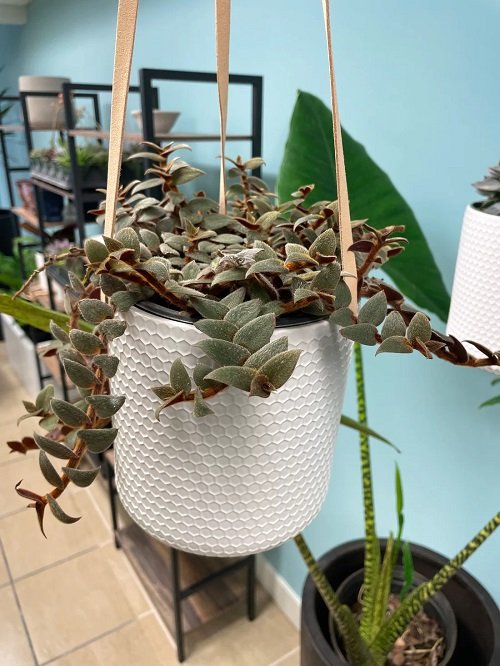
Botanical Name: Cyanotis kewensis
A charming and trailing houseplant with silvery-green leaves adorned with striking purple undersides.
Air Purifying: Moderate air-purifying, adds beauty, reduces stress.
Sun exposure: Bright, indirect light; protect from direct sun.
Temperature: 65°F to 75°F (18°C to 24°C). Avoid extremes.
Care: Indirect light, moderate temp, even watering, higher humidity, well-draining soil, occasional pruning, watch for pests, report as needed.
Watering: Evenly moist, avoid waterlogging.
Propagation: Through stem cuttings in water or soil.
Fertilization: Balanced liquid fertilizer, 4-6 weeks, diluted.
Height: 6-12 inches (indoor) to 6 feet+ (outdoor).
Hardiness Zone: 9-11 (can adapt to cooler zones).
27. Monstera Peru
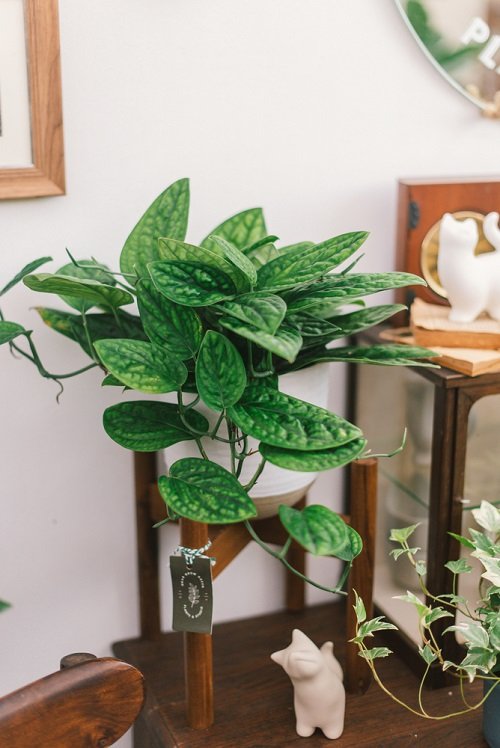
Botanical Name: Monstera karstenianum
Monstera Peru Popular tropical houseplant, Araceae family, native to Central and South America.
Air Purifying: Air-purifying, improves indoor air quality.
Sun exposure: Bright, indirect light.
Temperature: Moderate temperatures, ideally between 65°F to 75°F (18°C to 24°C).
Care: Indirect light, 65°F-75°F temp, even watering, higher humidity, well-draining soil, occasional pruning.
Watering: Even watering, avoid waterlogging.
Propagation: Propagate through cuttings.
Fertilization: Balanced liquid, diluted, every 4-6 weeks in growing season.
Height: Height: 6-12 inches indoors, up to 3 feet+ in optimal conditions.
Hardiness Zone: 10b, 11a, 11b, 12a, 12b.
28. Pilea
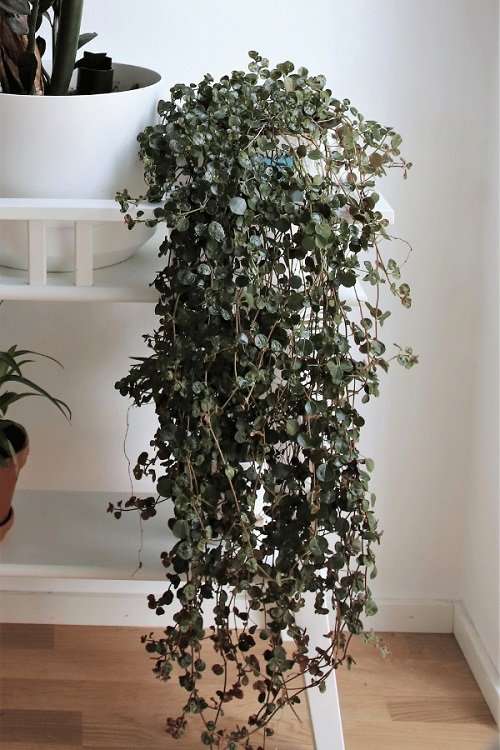
Botanical Name: Pilea Depressa
Pilea Depressa, also known as Baby Tears, is a delightful and low-growing houseplant.
Air Purifying: Air-purifying, improves indoor air quality, adds beauty.
Sun exposure: Bright, indirect light.
Temperature: 65°F to 75°F (18°C to 24°C).
Care: Bright, indirect light; even watering; moderate temperatures; well-draining soil; occasional pruning.
Watering: Keep soil evenly moist, but avoid waterlogging.
Propagation: Through stem cuttings in water or soil.
Fertilization: Diluted, balanced liquid fertilizer, 4-6 weeks in growing season.
Height: Typically a few inches to a foot (around 5-30 cm).
Hardiness Zone: 10-12, prefers 15-25°C (60-70°F).






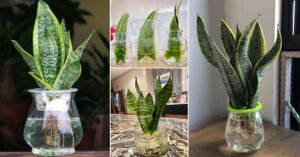
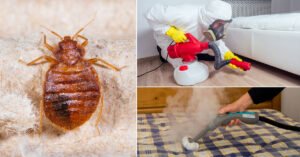

Average Rating